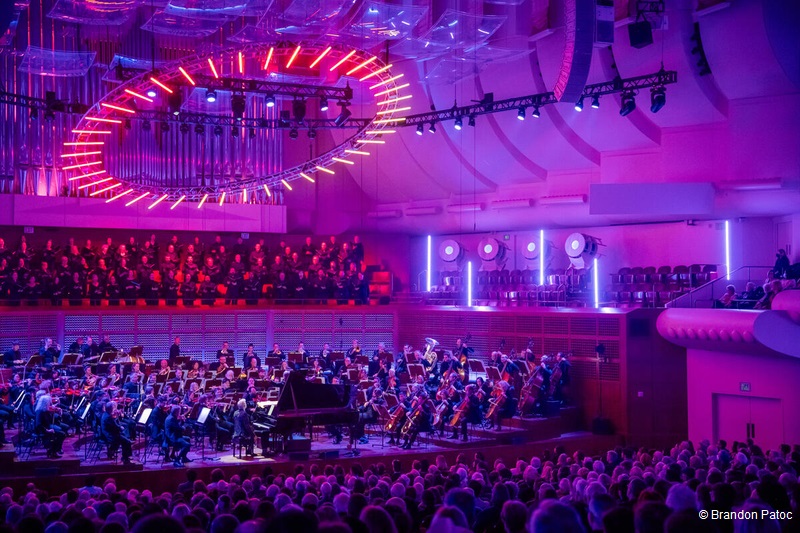
HARNESSING MULTIPLE SENSES FOR SYMPHONY: AN ENIGMATIC PAIRING
Back in the 20th century, we acquired television.
And in the 21st, we have now moved on to smellevision, fulfilling suppressed aspirations of 19th century composer Alexander Scriabin. It was a long time coming.
Bathing in choreographed fragrances for the first time in memory, the S.F. Symphony treated its patrons to a multi-sensory extravaganza of Scriabin’s 20-minute “Prometheus: Poem of Fire” music, with brilliant colored lights, and pleasant smells on cue piped into Davies Hall. This was as much a dazzling opera production—ultra-lavish, too— as a symphonic event with dense sonics and even a piano soloist.
No question, the patrons got a lot of bang for their buck and then some.
The Russian spiritualist Scriabin (1872-1915) has long ranked among the mystery figures in music, long on high-faluting ideas but short on repertory (Has anyone heard any other works, apart from that cousin opus, “Poem of Ecstasy?”). Like Wagner, Scriabin sought the multi-dimensional in music, in part because he was synesthesic—getting strong and specific color images from hearing certain musical chords. In this composition he had sought to blend music, movement, colors and fragrances. In this costly SFS go-round, with at least a dozen fragrance-spewing oversize cylinders working on cue with valves, he combined three of our five senses.
Instead of producing earworm themes, the nebulous Scriabin overharmonized his music, with his trademark mystical 6-tone chord full of amiable dissonances—-which he got away with. He placed the biggest clashes far apart—for instance, with G and F-sharp nearly an octave apart, instead of an ear-jarring side-by-side. Around the turn of the century his heavy chordal approach was closest to music of Busoni and Balakirev while also drawing close to Debussy’s barline-free compositional thrust. The central performer for this knuckle-testing score was the ubiquitous virtuoso pianist Jean-Yves Thibaudet, coming over here from France almost annually.
Scriabin’s sketchy scenario featured the Greek God Prometheus bringing fire down to the humans—reflected in the center section via the odor of a wood fire. Versus the opening section’s forest-like smell, and the finale’s bergamot, with hints of verbena and fresh grass, all thanks to designer Mathilde Laurent of la Maison Cartier.
Almost lost in the heady smells was the great collection of multi-color light tubes fluctuating overhead, maybe 30 strong, plus a short wordless chorus.
If this was not great memorable music, it was great sensory immersion for the patrons, who had come in droves despite the poor weekend weather.
Where Scriabin was sensual, Bela Bartok was profound and intellectual with the concert version of his somber one-act opera “(Duke) Bluebeard’s Castle” reflecting his own Symbolist leanings. Bluebeard’s ever curious and devoted new bride Judith was at odds with the intensely private Bluebeard, whose personality closely mirrored Bartok’s own. The contrast between the two, newly married, makes for drama within the fantasy scenes, Judith being consistently loving, curious and sunny as one bleak, bloody castle door after the other is unlocked, ending with the one harboring Bluebeard’s previous wives.
The high point, in this production of the hour-long work, was with the opening of the view of Bluebeard’s vast glorious kingdom, leading to outbursts of orchestral fortissimos and full, blinding lighting (left over from “Prometheus”). Throughout, Bartok softened his more severe musical style in favor of dark-romantic, perhaps aware of the problems of getting productions, particularly given the complexities of that unique Hungarian language. Not surprisingly, the Metropolitan Opera using the original Hungarian (as here) never produced it till a century later.
The two-person cast (mezzo Michelle DeYoung, bass-baritone Gerald Finley) was exceptional, bringing forth the deep contrasts between the figures.
However different in character, the two works make a strong pairing—both from 1911 and both Symbolist in style and content. And conductor Salonen merited plaudits for programming the two side by side while bringing in the rare Scriabin accessory features.
S.F. SYMPHONY with music of Scriabin, Bartok, soloists, all under Music Director Esa-Pekka Salonen and lighting designer Luke Kritzeck, encountered March 2 at Davies Hall, San Francisco. For SFS info: (415) 864-6000, or go online www.sfsymphony.org.